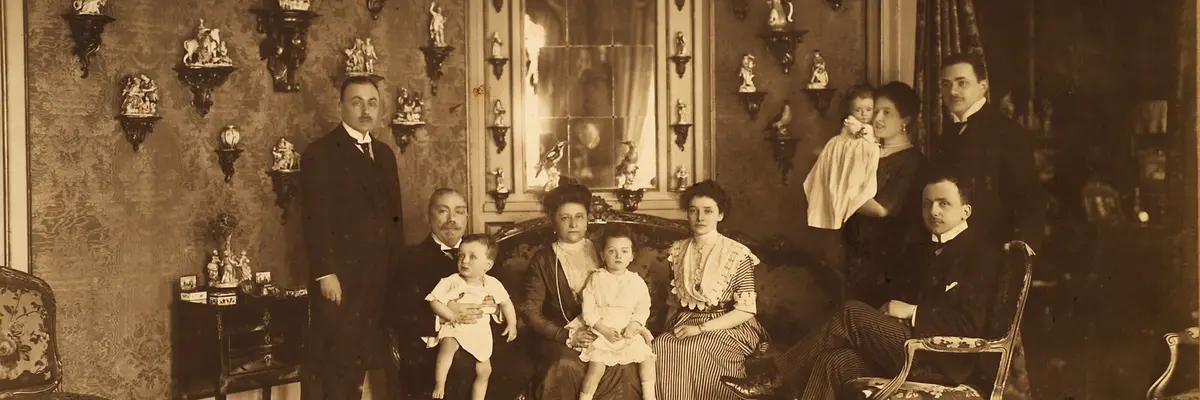
Background
The banker Gustav von Klemperer (d. 27 December 1926 in Dresden) bequeathed his precious porcelain collection to his three sons, Victor (1876–1943), Herbert Otto (1878–1951) and Ralph Leopold (1884–1956). From the early 1930s, the collection was housed in the eldest son’s villa on Tiergartenstrasse by the park known as the ‘Grosser Garten’.
In the late 1930s, the general political situation and increasing acts of repression against Jewish citizens forced the von Klemperers to seek refuge in other countries. While Victor and Ralph Leopold fled with their families to South Africa, whence Victor finally moved to Southern Rhodesia (now Zimbabwe), Herbert Otto, who lived in Berlin, emigrated to England. From the November Pogrom of 1938 onwards, it was clear that it would no longer be possible for the families to return to Germany – not even for a limited time in order to put certain matters in order and salvage at least a few personal possessions.
In the same month, November 1938, the Gestapo seized all the furnishings, art works and objets d’art from the villa on Tiergartenstrasse, including Gustav von Klemperer’s porcelain collection, which the then director of the Dresden Porcelain Collection, Fritz Fichtner, had already been conspiring to acquire for his museum. In December 1938, the collection was transported to the Johanneum (not far from the Frauenkirche), which still housed part of the Dresden Porcelain Collection.
In November 1941, in accordance with the Eleventh Supplementary Decree on the Reich Citizenship Law (Reichsbürgergesetz), the entire estate of the von Klemperer family became the property of the German Reich. In January 1943, on the basis of a personal decision on the part of Adolf Hitler, the Klemperer Collection was transferred, free of charge, into the ownership of the state of Saxony, that is to say, to the Dresden Porcelain Collection.
During the Second World War, the Gustav von Klemperer Porcelain Collection was evacuated for safe keeping, along with objects from the Dresden Porcelain Collection, to locations outside the city, mainly castles and country houses. In 1943, accordingly, the Klemperer Collection found its way to the baroque country seat of Schloss Rammenau between Dresden and Bautzen.
In the first months of 1945, the advance of Soviet troops made it necessary for the art works to be moved once again; consequently, a number of depots east of the Elbe were vacated and the art works brought to locations further west. In the course of this second transport, the crates containing the Gustav von Klemperer porcelain collection were removed from Schloss Rammenau and taken to a number of different storage sites.
After the end of the war, art works stored outside Dresden gradually returned to the Saxon capital and its museums. Nevertheless, there had been severe losses: hostilities, plundering and wanton destruction had decimated the holdings evacuated for safe keeping. This was also true of the porcelain collection looted from the von Klemperer family in 1938. Objects from the collection that had survived the ravages of the war found their way – partially without their true provenance being recognized – into the holdings of the Dresden Porcelain Collection.
Only after the reunification of Germany in 1990 did the von Klemperer family have any success in approaching the Dresden State Art Collections in order to have research conducted into the fate of the art treasures confiscated during the Nazi period. Prior to 1989, all the applications made by the family had been rejected on spurious grounds or never granted a proper response.
In 1991, the Porcelain Collection of the Dresden State Art Collections made a first restitution to the von Klemperer family. Illustrations in the catalogue published in 1928 had made it possible to identify 85 objects as having belonged to the Gustav von Klemperer Collection. Of these 85, the von Klemperer family only accepted 23; the remaining pieces, 62 in number, entered the holdings of the Dresden Porcelain Collection as gifts. In the same year, the 23 pieces accepted back by the von Klemperer family were sold at auction at Christie’s, London.
In 2010, after years of extensive research into the museum holdings and into the Klemperer Collection, the Dresden Porcelain Collection made one further major restitution to the von Klemperer family. The objects contained in this restitution had to a large extent only survived the form of shards or fragments, making it extremely difficult to identify them with certainty. A number of the objects, some only preserved in fragmentary form, were sold at auction at Bonhams, London, in 2010.
